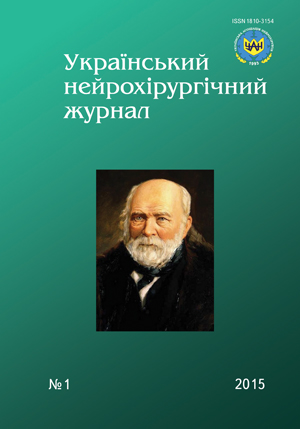Invasive monitoring of blood pressure on stages of cerebral aneurysms endovasal coiling
DOI:
https://doi.org/10.25305/unj.42709Keywords:
cerebral arterial aneurysm, coiling, invasive blood pressure measurementAbstract
The purpose. To study haemodynamic changes in major cerebral arteries and in arterial aneurysm’s (AA) cavity on stages of endovascular embolization for prognosis of intraoperative complications and postoperative period course.
Materials and methods. At the real time blood pressure (BP) in 44 patients was compared in internal carotid artery (ICA) and in AA cavity while performing endovascular coiling at subarachnoid hemorrhage, caused by AA rupture.
Results. BP in a main artery during the surgery performing did not change substantially. Systolic BP changed on intermediate stages of embolization, BP changes were identified inside AA cavity. It was noted that in 43.2% patients systolic BP inside AA decreased and was about (30.7±9,1) mm Hg, in 56,8% increased by (27,6±4,7) mm Hg. After AA cavity embolization BP decreased in average on 7.7 mm Hg, thus BP correlation in AA cavity and ICA decreased from 87.3 to 77.9%.
Conclusions. Invasive measurement of BP did not significantly affect duration of the surgery and was not accompanied by additional trauma. Hemodynamic parameters assessment in the artery and AA provided further information about the course and efficacy of endovascular neuroroentgenosurgical intervention, systolic BP increasing in AA cavity may indicate an increased risk of AA intraoperative rupture.
References
Gupta B. Invasive blood pressure monitoring. Update in Anaesthesia. 2012;28:37–42.
Chalouhi N, Jabbour P, Singhal S, Drueding R, Starke RM, Dalyai RT, Tjoumakaris S, Gonzalez LF, Dumont AS, Rosenwasser R, Randazzo CG. Stent-Assisted Coiling of Intracranial Aneurysms: Predictors of Complications, Recanalization, and Outcome in 508 Cases. Stroke. 2013;44(5):1348-1353. CrossRef.
Klimov AB. Endovaskulyarnoye lecheniye arterial'nykh anevrizm golovnogo mozga [Endovascular treatment of arterial brain aneurysms] [dissectation]. [Moscow]: Sklifosovsky Research Institute of Emergency Care; 2005. Russian.
Murayama Y, Nien YL, Duckwiler G, Gobin YP, Jahan R, Frazee J, Martin N, Viñuela F. Guglielmi Detachable Coil embolization of cerebral aneurysms: 11 years' experience. Journal of Neurosurgery. 2003;98(5):959-966. CrossRef.
Levitt MR, McGah PM, Aliseda A, Mourad PD, Nerva JD, Vaidya SS, Morton RP, Ghodke BV, Kim LJ. Cerebral Aneurysms Treated with Flow-Diverting Stents: Computational Models with Intravascular Blood Flow Measurements. American Journal of Neuroradiology. 2013;35(1):143-148. CrossRef.
özdamar N, Çelebi G. Pressure distribution on the wall of experimental aneurysms. Acta Neurochirurgica. 1978;45(1-2):27-34. CrossRef.
Sekhar L, Sclabassi R, Sun M, Blue H, Wasserman J. Intra-aneurysmal pressure measurements in experimental saccular aneurysms in dogs. Stroke. 1988;19(3):352-356. CrossRef.
Ferguson G. Direct measurement of mean and pulsatile blood pressure at operation in human intracranial saccular aneurysms. Journal of Neurosurgery. 1972;36(5):560-563. CrossRef.
Ferns S, Schneiders J, Siebes M, van den Berg R, van Bavel E, Majoie C. Intracranial Blood-Flow Velocity and Pressure Measurements Using an Intra-Arterial Dual-Sensor Guidewire. American Journal of Neuroradiology. 2009;31(2):324-326. CrossRef.
Gobin Y, Counord J, Flaud P, Duffaux J. In vitro study of haemodynamics in a giant saccular aneurysm model: influence of flow dynamics in the parent vessel and effects of coil embolisation. Neuroradiology. 1994;36(7):530-536. CrossRef.
Acar F, Men S, Tayfur V, Yilmaz O, Erbayraktar S, Metin Güner E. In vivo intraaneurysmal pressure measurements in experimental lateral wall aneurysms before and after onyx embolization. Surgical Neurology. 2006;66(3):252-256. CrossRef.
Hashimoto T. Flow velocity studies in vein pouch model aneurysms. Neurol Res. 1993;15(3):185-91.
Sadasivan C, Fiorella D, Woo H, Lieber B. Physical Factors Effecting Cerebral Aneurysm Pathophysiology. Ann Biomed Eng. 2013;41(7):1347-1365. CrossRef.
Jeong W, Rhee K. Hemodynamics of Cerebral Aneurysms: Computational Analyses of Aneurysm Progress and Treatment. Computational and Mathematical Methods in Medicine. 2012;2012:1-11. CrossRef.
Cebral JR, Mut F, Raschi M, Scrivano E, Ceratto R, Lylyk P, Putman CM. Aneurysm Rupture Following Treatment with Flow-Diverting Stents: Computational Hemodynamics Analysis of Treatment. American Journal of Neuroradiology. 2010. CrossRef.
Larrabide I, Aguilar ML, Morales HG, Geers AJ, Kulcsár Z, Rüfenacht D, Frangi AF. Intra-Aneurysmal Pressure and Flow Changes Induced by Flow Diverters: Relation to Aneurysm Size and Shape. American Journal of Neuroradiology. 2012;34(4):816-822. CrossRef.
Shobayashi Y, Tateshima S, Kakizaki R, Sudo R, Tanishita K, Vinuela F. Intra-aneurysmal hemodynamic alterations by a self-expandable intracranial stent and flow diversion stent: high intra-aneurysmal pressure remains regardless of flow velocity reduction. Journal of NeuroInterventional Surgery. 2012;5(Suppl 3):iii38-iii42. CrossRef.
Schneiders J, VanBavel E, Majoie C, Ferns S, van den Berg R. A Flow-Diverting Stent Is Not a Pressure-Diverting Stent. American Journal of Neuroradiology. 2011;34(1):E1-E4. CrossRef.
Silveira P, Miller C, Mendes R, Galego G. Correlation between intrasac pressure measurements of a pressure sensor and an angiographic catheter during endovascular repair of abdominal aortic aneurysm. Clinics. 2008;63(1). CrossRef.
Downloads
Published
How to Cite
Issue
Section
License
Copyright (c) 2015 Volodymyr Shevaga, Andriy Netlyukh, Oleg Kobyletsky, Viktor Salo

This work is licensed under a Creative Commons Attribution 4.0 International License.
Ukrainian Neurosurgical Journal abides by the CREATIVE COMMONS copyright rights and permissions for open access journals.
Authors, who are published in this Journal, agree to the following conditions:
1. The authors reserve the right to authorship of the work and pass the first publication right of this work to the Journal under the terms of Creative Commons Attribution License, which allows others to freely distribute the published research with the obligatory reference to the authors of the original work and the first publication of the work in this Journal.
2. The authors have the right to conclude separate supplement agreements that relate to non-exclusive work distribution in the form of which it has been published by the Journal (for example, to upload the work to the online storage of the Journal or publish it as part of a monograph), provided that the reference to the first publication of the work in this Journal is included.









